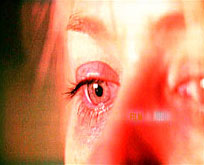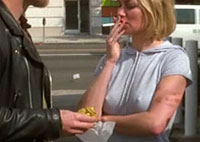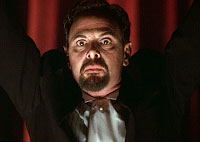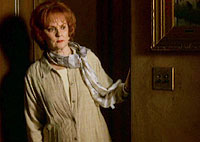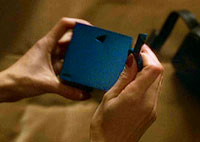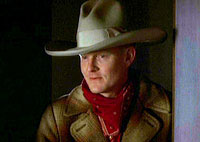|
|
Threads: Related: The Painting | Audition | Woody | Lorraine Kesher |
The sexual abuse theory postulates that much of what we see in the film can be attributed to Diane having experienced child abuse at the hands of someone close to her. Clues:
|
|
|
Grandpa? |
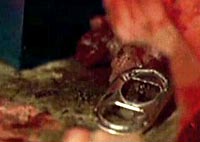
|
|
Pop top & raw meat in paper sack |
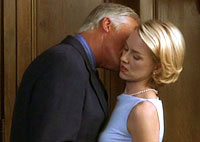
|
|
Dad's best friend goes to work |
|
|
|
Prostitute bruised |
|
|
|
Physical violence in the couch scene |
|
|
|
Fan by fireplace in Diane's apt |
|
|
|
Ceiling fan in Twin Peaks |
|
|
|
Magician miming a climax? |
|
|
|
Ruth not seeing things |

|
|
Disheveled clothing |

|
|
A deal for silence? |
|
|
|
Phallic symbolism |
|
|
|
The abuser? |
-
At the airport, we hear the old lady saying "It's been so nice travelling with you.", but as Betty is arriving for her new life she parts with them there. Betty/Diane sees them leaving in the limo, but with very menacing looks on their faces, suggesting that even though she has left them behind, they are still lurking out there as a possible menace in ways of memories of her sexual abuse »more
A little girl's and a man's giggle followed by high-pitched screams heard before the old couple drive Diane down the hallway into her bedroom. We could see this as a repressed memory coming back to Diane
-
In the end the old couple coming from the paper sack, with a pop top and a piece of raw meat, representing use, abuse and discarding her. You also could read the rotten corpse in her bed as Diane's abused body
-
Betty comes from Deep River, Ontario. "Deep River" was the name of the apartment complex of Dorothy in "Blue Velvet", where she is repeatedly abused by Frank »MD Trivia
-
The "Beatrice Cenci" painting in aunt Ruth's apt. is of the famously abused woman who had her abuser killed
-
Another one that is not at all obvious but certainly an easier connection (than the painting) is the Rita Hayworth poster. It's no secret that Hayworth was an alleged incest victim by her father. She was dancing professionally with him when she was only 12 »Real Life Connection
The audition scene:
In this scene she was rehearsing with an actor named Woody and Betty's character referred to him as Dad's Best Friend. Woody and Dad's best friend are references to a penis and Betty's abuser (»more on Woody Katz ). In her dream Betty takes control and flips the tables. She is the one who makes the more sexual advance towards Woody. This is Diane's way of dealing with her abuse by (in her dream) trying to take control of it.
In Twin Peaks it is Laura Palmer who refers to Bob as "DAD'S BEST FRIEND". Bob (her father's "evil identity") has sexually abused her for years-
Director: "Don't play it for real until it gets real!". That Betty/Diane can imagine how to play this scene "for real" must give us pause to think why she can do it so well. What does she bring from her background to the role that helps her understand it so well?
The naivety of Betty saying how Wally must be ok because he seems so nice and he is a friend of her aunt
-
The bruises on the prostitute's left arm indicate sexual violence
When Adam opens the door to find Lorraine in bed with the pool man, latter says, "Just forget you ever saw it. It's better that way." This dialogue is Diane's mind telling her to repress the memories
The pool man's name is GENE, he is a POOL cleaner, he's having SEX with Adam's wife. Put three of the most prominent aspects of his character together and you get "genepool sex", which could indicate incestuous abuse
-
In the sex scene on the couch, when Camilla says "We shouldn't do this anymore", instead of asking why? or being hurt, Diane does what worked for her abuser, tells Camilla viciously "don't ever say that" and hurts her physically
-
There has never been an actual film made called "The Sylvia North Story." But interestingly enough, in 1965, during the possible time period of the songs sung during the audition, there was a movie called "Sylvia." The title character's full name was Sylvia West, and the movie recounts how the title character was raped by her step-father at the age of 14, and how she became a prostitute when she was older
-
There is a potential that children who are sexually abused end up being in adult/sexual relationships with an abusive partner. Diane was definitely mentally/psychologically abused by Camilla. So the abuse in her youth might have caused her to end up in a very abusive, unfulfilling relationship now
-
We see (presumably) Aunt Ruth scan the room and look precisely at the same spot on the carpet where the blue box dropped down. Only Aunt Ruth sees nothing. Suggesting that the abuser was the male and the female partner either overlooked it, turned a blind eye to it, or somehow missed it altogether. Ruth = "Grief" or should we see "aUNTRUTH"?
-
Peculiar violence in the masturbation scene. Also, when Diane masturbates, we see a fan for a few frames against the blurring wall. Could it be a reference to the ceiling van in Twin Peaks? Leland used to turn the fan before raping his daughter
-
In Club Silencio, one female in the audience bears a striking resemble to Sheryl Lee who played Laura Palmer in Twin Peaks (who had been abused by her father) »more
-
Strange human sounds in Silencio, before Betty goes under convulsion
-
The Magician as the abuser:
At the end of his performance Betty's body gets tense and starts shaking uncontrollably. While she does this, the magician's face looks like he is straining, and he is somewhat tense as well. And then, suddenly there is the sound of a man making a grunting sound, like he is releasing something pent up inside of him. Then the magician relaxes with an evil grin on his face, as Betty also relaxes finally, looking unsure of what just happened. The magician was forcing Diane to relive how her Betty-like innocence was lost long ago when she had been raped as a child »Club Silencio and the abuse
Aunt Ruth and the bedroom - (maitlands)
If the appearance of Aunt Ruth as the last image prior to the "transition to reality" is intended to be seen as a visualization of Diane's subconscious activity, then the choice suggests that it must have a significance to her that should not be underestimated. What this image could be signaling/representing is the repressed notion that Aunt Ruth somehow missed, overlooked or ignored something that happened in Diane's bedroom that had such devastating traumatic impact on the latter that it led her to escape into a fantasy world, but as it continues to threaten to surface towards conscious recognition, simultaneously destroys any hope of escape through fantasy.
Could some atrocious "accident" have taken place in Diane's bedroom when she was young? Could Aunt Ruth have been part of it in some way? Did she ignore/partake in it? Was she paid to keep it quiet (and then did she subsequently bequeath the money to
Diane out of guilt)? Was Aunt Ruth's sin of omission/silence the most traumatic part for
Diane?
Think about some of the images that appear in the bedroom at, on, or more precisely just to the left
of the bed:
-
We see discarded/disheveled clothing (which is explained quickly thereafter by an image of a woman trembling in a shower, trying to get herself clean and having suffered a severe loss of self-identity)
-
We see a great deal of money passed from one hand to another, we see a handshake deal that a secret be kept regarding that money. The deal is made without a word being exchanged
-
We see a clouded/distorted image of a young blonde girl surrounded by two old people just prior to a face hitting a pillow - (it is barely perceptible as though the person seeing it is trying to repress it)
-
We hear that the person whose face hits the pillow is breathing in a very distressed manner and the camera moves in such a way to suggest that the person whose face hits the pillow has just picked herself up from the floor/rug. At Club Silencio we see Rebekah Del Rio collapsing on a rug. Next scene, a blue box falls on (similar looking) rug
-
We see a long thin cylindrical object with a bulbous end inserted into a box - both are blue, the colour of sadness. A phallic key hastily and crudely inserted into a "box" to satisfy a deep but dangerous curiosity and suddenly whole identities disappear. Betty vanishes - perhaps subconsciously Diane cannot bear to be around when this repressed "accident" surfaces into recognition
-
And it's certainly no coincidence that, after the two old people chase Diane into the bedroom, she is ending her life on the bed
I was always a believer that Diane was abused as a child, most likely by a family member. Not only because of the clues in the film, but also because of the prevalence of child abuse in Lynch's films. However, I was never really convinced that her abuse was central to the film's meaning, until recently. Diane's uncle or father (or whoever it might have been) sexually abused her as a child, and Aunt Ruth knew about it. Diane threatened to tell someone what was happening, but Aunt Ruth couldn't bear the secret to be let out, so she makes an agreement between the two of them. If Diane keeps quiet, she can have some (or all) of her aunt's money when she's gone. However, the damage this did to Diane was enormous. "Silencio." There are those who believe one of the greatest sins there is, is silence.
Related Theory: Diane's dream is a replay of her sexual abuse
The Cowboy representing the abuser
With the Cowboy being the last image of Diane's fantasy, he becomes associated to the harsh reality or rude awakening that forces her out of her dream world. What he says and does brings her back to her world of despair. This leads me to believe that we can connect his actions very closely to the actions of Diane's grandfather, because he is the one associated with her harsh reality. He came into her bedroom one morning saying "Hey pretty girl. Time to wake up." What he saw was the young Diane who, while still a girl, was now starting to express a womanly sensuality, much like that of the Rita persona. This caused a terrible "accident," which is to say, something overcame the grandfather and he sexually abused Diane. Then when he leaves, the girl's image has changed to the bullet-ridden image of the dead Diane Selwyn, the one that is some terrible mixture of the Rita and Betty personas. And from thereafter, her girlishness and womanliness were never able to merge in a healthy way. This is the harsh reality that greets Diane as she awakens from her fantasy. - (Alan Shaw)
Adam/Lorraine/Gene: A replay of Diane's sexual abuse?
 Before
we get to Adam/Diane's home we go back to a scene with Betty and Rita, and Betty
asks, "I wonder where you were going?"
And Rita answers, "Mulholland Drive."
That is in fact where Adam's home was and it is also where a great big
accident happened that changed everything. In
this context I believe the accident becomes a metaphor for a terrible thing that
happened in real life to Diane when she was still a girl.
And what was the terrible thing? It
is revealed when Adam gets home. He
discovers a terrible infidelity. In his
real life it was between his wife, Lorraine, and Gene, the pool man.
Before
we get to Adam/Diane's home we go back to a scene with Betty and Rita, and Betty
asks, "I wonder where you were going?"
And Rita answers, "Mulholland Drive."
That is in fact where Adam's home was and it is also where a great big
accident happened that changed everything. In
this context I believe the accident becomes a metaphor for a terrible thing that
happened in real life to Diane when she was still a girl.
And what was the terrible thing? It
is revealed when Adam gets home. He
discovers a terrible infidelity. In his
real life it was between his wife, Lorraine, and Gene, the pool man.
But what does this mean in Diane's life. The
first clue is that Lorraine is a blonde, and this means she may have some
connection to Diane. But who does the
pool man represent who had sex with her? The name of the man is GENE POOLman,
i.e. incestual abuse is what is the issue. The
next clue is that Adam takes the family jewels and pours pink paint all over
them. The "family jewels" is a
slang term for the testicles of the man of the family, and pink paint represents
Diane's innocent sexuality. So, by
pouring pink paint over the family jewels Adam is showing us that it was the
father figure who had sex with Diane. When
you place this idea into the context of the infidelity that Adam has discovered,
we can deduce that what Adam is told when he comes into the bedroom may have
been what Diane was told when the incest was discovered.
Because of that dialogue we can assume that Diane was probably blamed for
what happened by her mother figure and told to keep it quiet by the father
figure. "Now you've done it,"
Lorraine says. "Just forget you ever
saw it. It's better that way," says
Gene. I believe that Adam's subsequent
beating and nosebleed is a metaphor for Diane's lost virginity. -
(Alan Shaw)
The whole middle of the movie is one prolonged scene revealing Diane’s troubled past, although superficially we see scenes that shift between different characters:
Rita and Betty discover the money, and the question of where the money came from is answered in the short street scene with the prostitute. (This scene is framed by two close-ups of Betty, the first being an extreme close-up into her eyes). After the money/prostitution scene follows Betty's urge to try to find out if there was also "an accident" (on Mulholland Dr), with "accident" being a symbol for the abuse. To this idea of exploring the accident Adam (in the car) states three times "I’m going home", indicating that it was "in the family"/"at home" that the abuse took place. After we then see the abuse scene "at home", Betty closes this segment of the movie with "Let’s hide it". In this composite scene Diane has laid open all her traumas, but she will not acknowledge them. Rita and Betty hide away the evidence, and in what? A BLUE BOX! (A hat box). After that they shake hands on the deal to suppress the evidence and go out, which means that Diane’s fantasy world can be upheld for a longer time. - (romdal)
You may note that there are no children in Lynch's work (except for that spooking child magician in "Twin Peaks"). The only child in "Blue Velvet" is being held hostage by Frank Booth. Even the high school girls in "Twin Peaks" are not children, but full-grown women, implying that sexual activity robs people of their childhood. The recurring theme of an outwardly innocent and happy world with a dark sinister secret is consistent with child sexual abuse. - (David Castenson)
!Following post contains major spoilers for other Lynch films: Lost Highway, Wild at Heart, Twin Peaks!
It does not seem like too broad a generalization to say that families in David Lynch films are not happy families. They are more likely to be incestuous and violent, twisted or torn apart by repressed memories and unspeakable secrets: Fred in Lost Highway murders his wife; Marietta Pace in Wild at Heart is complicit in her husband's death and tries to seduce her daughter's boyfriend; Leland Palmer molests and kills his daughter Laura in Twin Peaks; in Blue Velvet Frank Booth obviously (and Jeffrey Beaumont, less obviously), has basic Oedipal issues to work through. And let it suffice to say of Eraserhead that Henry Spencer's dinner with his girlfriend Mary's family, the Xes, is among the least pleasant of all the strained and unpleasant family dinner scenes ever filmed (possibly excepting the one in Fire Walk With Me), and that the nuclear family unit formed by Henry and Mary and their infant is also less than traditionally strong and nurturing. Given all that, we would be willing marks if we weren't skeptical about any family-values platitudes uttered by one of Lynch's characters, or suspicious of a Lynchian family that didn't conceal an internecine crime at its heart. - (Tim Kreider & Rob Content)
A movie about mind control? - (Rochas Triumphant)
A list of behaviours, evinced by Betty/Diane, which suggest that she has been part of a mind-control programme at some point in her young life:
-
Traumatic nightmares, incorporating entities and situations that refer indirectly to past abuses, though likely are not strict facsimiles of actual scenes of abuse
-
Sleep cycle initiation and disruption by encoded modifiers (like, for example, a guy in a big cowboy hat dropping by with canned lines)
-
Memory lapses and missing time
-
Structured, dissociated states, producing manifest personalities with varying operational capacities, consistent with Project BLUEBIRD-style conditioning
-
Abnormal attention to iconography and symbology, common or uncommon
-
In females, sudden initiation of sexual advances, consistent with Project Monarch-style training
-
Infantilisation and age-regression during stress
-
Abnormal emphasis upon control and routine, to avoid conflict and subconscious fragmentation
-
Inability for one dissociated personality to expressly recognise (give countenance to) another (e.g. voice recordings)
-
Association of pain responses with specific, external abuse-figures
-
Retreat from actual interpersonal relations into an idealised, fantasy world
-
Susceptibility to hallucination, particularly twinning or multiple 'alters'
-
Confusion and inability to focus when not 'bedded' in a given persona
-
Natural abilities to 'inhabit' roles as an actor, particularly within the Stanislavsky or 'Method' school of theatre and film acting; ability to rapidly 'shed' and 'acquire' roles
-
Advanced skills in lying and dissimulation, often performed without extensive conscious thought
-
Dissonant personal history, including plausible but unverifiable information which may seem unusually dated, prosaic or unrealistic
-
Moral passivity in situations which would ordinarily produce extreme emotional and ethical reactions
-
Full-spectrum responses typical of post-traumatic syndromes
-
Suicidal tendencies, possibly resulting from 'self-destruct' conditioning to provide cleanup at mission closure
-
Drug dependence and abuse, leading from ameliorative self-medicative efforts
-
Friends and loved ones frequently report the subject as being 'somehow absent' or dislocated from their everyday context
-
Sudden disappearances, often for extended durations with concurrent appearance at locations with no known link to the previous life of the subject, and subsequent commencement of alternative life with new name, identity, lifestyle, etc. consistent with the as-yet-theoretical controlled dissociative fugue state
